-
WANTED: Happy members who like to discuss audio and other topics related to our interest. Desire to learn and share knowledge of science required. There are many reviews of audio hardware and expert members to help answer your questions. Click here to have your audio equipment measured for free!
You are using an out of date browser. It may not display this or other websites correctly.
You should upgrade or use an alternative browser.
You should upgrade or use an alternative browser.
Sensitivity and Dynamic Range
- Thread starter luft262
- Start date
fieldcar
Addicted to Fun and Learning
YepWill a more sensitive speaker simply be able to play louder with a given amplifier
Sure, it takes less power at any sound level. And as long as it can output more (not a given), it will have more dynamic range.
MaxwellsEq
Major Contributor
- Joined
- Aug 18, 2020
- Messages
- 1,787
- Likes
- 2,734
As cheap as amplifier power is, it's not much of a problem anymore unless you're in Pro audio.
- Thread Starter
- #6
I'm wondering that. I'm also wondering if there is an advantage to speakers with a higher sensitivity other than just the ability to play louder with a given amplifier. For example, if there is more dynamic range then tower speakers might have an advantage over standmount speakers beyond just lower bass extension. Just curious.Hi @luft262 are you now wondering why we don't all use high efficiency loudspeakers?
Some towers have multiple bass and midrange drivers. Those typically will go louder. There's no replacement for displacement.
Well, except horns. You don't want to know how big bass horns have to be.
Well, except horns. You don't want to know how big bass horns have to be.
Suffolkhifinut
Major Contributor
- Joined
- Dec 8, 2021
- Messages
- 1,224
- Likes
- 2,029
Don’t agree! Are you confusing loudness for a given power input with dynamic range?Sure, it takes less power at any sound level. And as long as it can output more (not a given), it will have more dynamic range.
MaxwellsEq
Major Contributor
- Joined
- Aug 18, 2020
- Messages
- 1,787
- Likes
- 2,734
Generally (it's always dangerous to generalise), everything else being equal, bigger boxes are more efficient.I'm wondering that. I'm also wondering if there is an advantage to speakers with a higher sensitivity other than just the ability to play louder with a given amplifier. For example, if there is more dynamic range then tower speakers might have an advantage over standmount speakers beyond just lower bass extension. Just curious.
No (?)Don’t agree! Are you confusing loudness for a given power input with dynamic range?
DVDdoug
Major Contributor
- Joined
- May 27, 2021
- Messages
- 3,062
- Likes
- 4,036
Speakers are essentially linear unless you push them into distortion so the "dynamic range" is determined by the maximum SPL. (Or limited by amplifier power.)
Of course a speaker with higher power handling capability, along with more amplifier power, may go louder and therefore have more dynamic range than a more efficient speaker with a lower power rating.
Of course a speaker with higher power handling capability, along with more amplifier power, may go louder and therefore have more dynamic range than a more efficient speaker with a lower power rating.
Cote Dazur
Addicted to Fun and Learning
Louder is not always desirable if it is at high distortion. The ability to play loud at low distortion is not directly related to sensitivity. Loud is also highly dependent on the size and how empty the room is. Sensitivity is only indicative of the kind of power you need to reach a certain level of SPL with 1 watt at 1meter.I'm also wondering if there is an advantage to speakers with a higher sensitivity other than just the ability to play louder with a given amplifier
The challenge with smaller speakers is that you will have to sacrifice sensitivity to reach the lower frequency range at a decent level of SPL as opposed to using larger or multiple woofers that do not require as much power to move air. With the right design and proper amplification, both tower and stand mount can reach the same level of SPL. How close you are from the speakers and how big the room is will have a bigger impact on what SPL than any given design you use.For example, if there is more dynamic range then tower speakers might have an advantage over stand mount speakers beyond just lower bass extension
Waxx
Major Contributor
The misunderstanding of higher sensitivity is more dynamic is just because typically you don't drive high sensitive speakers to their limits, while with lower sensitive speakers it happens faster. You also need less power for the same power or dynamic range with higher sensitive speakers. But there is no direct link between the two. A low sensitive speaker that can handle a lot of wat is as sensitive as a high sensitive speaker that only can handle a few watt. Because both have the same headroom more or less.
So as a simplified example: I have 98dB sensitive speakers (8R) that are amped with 15w amps (also diy) and those are more dynamic than my 89dB sensitive speakers (also nominal 8R) with 35W amp, because max volume of the 89dB speakers with that amp is 103dB, and the 98dB speakers with the 15w amp is 110. So i have 7dB more headroom to not limit the dynamics of the music. But if that 89dB speakes could handle it (they can't) and have an amp that also can bring them to 110dB (but then i would need 256w), the dynamics would be the same. It's in reality not as simple as explained here (other factors are also into play) but it's largely like that.
So as a simplified example: I have 98dB sensitive speakers (8R) that are amped with 15w amps (also diy) and those are more dynamic than my 89dB sensitive speakers (also nominal 8R) with 35W amp, because max volume of the 89dB speakers with that amp is 103dB, and the 98dB speakers with the 15w amp is 110. So i have 7dB more headroom to not limit the dynamics of the music. But if that 89dB speakes could handle it (they can't) and have an amp that also can bring them to 110dB (but then i would need 256w), the dynamics would be the same. It's in reality not as simple as explained here (other factors are also into play) but it's largely like that.
Waxx
Major Contributor
And the reason why we don't see high sensitive speakers on the hifi market (or very little) is very simple: the size. Fashion dictates small speakers and low sensitive that can go low can be small, high sensitive that can go low not. That 98dB speaker i was talking about is 190L internal, that lower sensitive is 17.9L (both are diy reflex designs by myself) and does not go that low (30Hz vs 45Hz as F3).
Will a more sensitive speaker simply be able to play louder with a given amplifier or will it have greater dynamic range
As others have said, a resounding yes to the first part of the question.
To the second part of the question, there is no direct correlation between high sensitivity and dynamic range - at normal listening volume (it depends on the quality and intended use of the drivers). That's another one of those audio myths.
Let's take a woofer with extremely hard suspension and and sufficiently large Bl. The sensitivity will be very high, but often the linear excursion of the driver is very limited and therefore it will show increased dynamic compression below 200Hz (maybe the driver has a small voice coil too, which could additionally lead to dynamic compression in the upper frequency range). In addition, resonances can lead to a reduction of the dynamic range in a certain frequency range.
It is very likely that an active studio monitor, due to the default active limiter, tends to have a lower dynamic range (very often in the bass range, partly also in the treble range), then a comparable passive version (without limiter).
To show this, here are a few comparisons of dynamic range from Erin's website.
For a fair comparison, please consider only frequencies above 100Hz (a speaker that doesn't reproduce 30Hz, has probably a lower dynamic compression than a speaker that plays linear down to 30Hz).
Small studio monitor with active limiter:

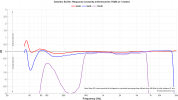
High sensitivity Hifi speaker:
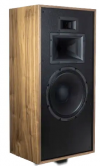
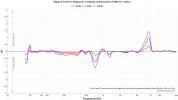
Huge PA speaker:
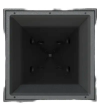
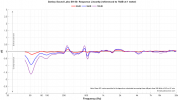
High sensitivity speaker:
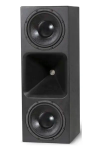

Small Hifi speaker:
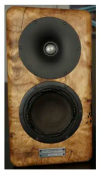
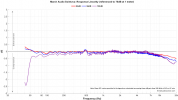
I could be miss reading all this but I think the question is: for any given track will higher sensitivity speakers give a greater difference in volume between the quiet sections of the track and the loud sections of the track?
If we disregard, or leave to later in the conversation, all the issues mentioned above ie: distortion, amplification, compression etc. then a more sensitive speaker should produce a greater variation in volume. If the speaker is simplified to being linear ie XdBSPL/volt then for any track that doubles its output voltage (say a loud drum hit) the speaker volume will increase by 2”X”. The bigger “X” the bigger the change.
Is this not correct?
Then of course distance to speaker and all the above issues need to be considered to determine the result in practice.
If we disregard, or leave to later in the conversation, all the issues mentioned above ie: distortion, amplification, compression etc. then a more sensitive speaker should produce a greater variation in volume. If the speaker is simplified to being linear ie XdBSPL/volt then for any track that doubles its output voltage (say a loud drum hit) the speaker volume will increase by 2”X”. The bigger “X” the bigger the change.
Is this not correct?
Then of course distance to speaker and all the above issues need to be considered to determine the result in practice.
solderdude
Grand Contributor
It is about dynamic compression (non linear behavior at larger swings) which is common in voicecoil speakers (also headphone drivers) at larger swings (so low frequencies) but at different levels and severity.
Last edited:
Gary_G
Active Member
I like that !There's no replacement for displacement
Great comparison, thank you for this. Very interestingAs others have said, a resounding yes to the first part of the question.
To the second part of the question, there is no direct correlation between high sensitivity and dynamic range - at normal listening volume (it depends on the quality and intended use of the drivers). That's another one of those audio myths.
Let's take a woofer with extremely hard suspension and and sufficiently large Bl. The sensitivity will be very high, but often the linear excursion of the driver is very limited and therefore it will show increased dynamic compression below 200Hz (maybe the driver has a small voice coil too, which could additionally lead to dynamic compression in the upper frequency range). In addition, resonances can lead to a reduction of the dynamic range in a certain frequency range.
It is very likely that an active studio monitor, due to the default active limiter, tends to have a lower dynamic range (very often in the bass range, partly also in the treble range), then a comparable passive version (without limiter).
To show this, here are a few comparisons of dynamic range from Erin's website.
For a fair comparison, please consider only frequencies above 100Hz (a speaker that doesn't reproduce 30Hz, has probably a lower dynamic compression than a speaker that plays linear down to 30Hz).
Small studio monitor with active limiter:
View attachment 263208View attachment 263206
High sensitivity Hifi speaker:
View attachment 263218 View attachment 263219
Huge PA speaker:
View attachment 263210 View attachment 263211
High sensitivity speaker:
View attachment 263214 View attachment 263215
Small Hifi speaker:
View attachment 263216 View attachment 263217
Similar threads
- Replies
- 20
- Views
- 1K
- Replies
- 11
- Views
- 855
- Replies
- 30
- Views
- 3K
- Replies
- 34
- Views
- 2K
- Replies
- 0
- Views
- 240
